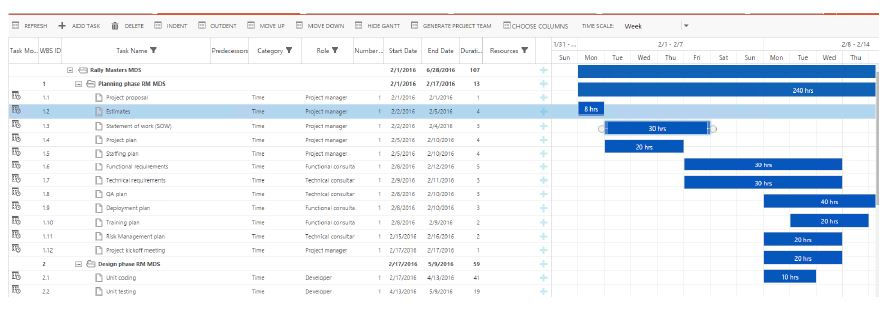Project Management in Dynamics 365

There are, essentially, two options when considering an end-to-end solution for managing projects with Microsoft Dynamics 365:
Utilizing D365 Operations (former AX7) which is a full ERP that includes a Project Management & Accounting module (this is what it was called in the older versions of AX); or
Purchasing D365 Financials (former NAV) and integrating it with the purchase of D365 PSA (Project Services Automation)
And there are significant differences between the two options, both in terms of breadth of functionality and also the amount of required customizations for lack of out-of-box interoperability.
MS Dynamics 365 Operations
D365Ops includes significantly more functionality designed for enterprise customers requiring deep functionality in sectors such as manufacturing, distribution, services. Microsoft defines enterprise as customers with 250+ employees. But that is an oversimplified definition and it really depends to the extent of a customer’s complex business processes which may or may not benefit from one seamlessly integrated ERP. For instance, an engineer-to-order manufacturer with multiple manufacturing facilities and warehouses around the globe and multi-currency sales would definitely benefit from D365Ops; in fact, this is the typical customer description of users of the older versions of Dynamics AX, now branded as Dynamics 365 Operations. Of course, the deep functionality also comes at a cost, roughly $230/month per user and a minimum commitment of 20 users is required.

Regarding Project Management functionality, the functionality within D365Ops is robust but, as a result, also more complex than might be required by some organizations. Benefits include revenue recognition, tax management, detailed procurement and other project-specific accounting functions. A good example of a need for this robust functionality would be for large complex projects that span over multiple fiscal years, involve multiple intercompany transactions, complex supply chain and/or manufacturing processes, etc..

In terms of integration, Microsoft is investing heavily in creating a Common Data Model (CDM) and Common Data Services (CDS) to seamlessly integrate all the dimensions and core data within Operations such that customizations will be at a minimum (Actually, on the short-term roadmap MS will eventually provide this kind of integration with Dynamics PSA, proving the benefits of the simplicity of PSA compared to the complexity of the management of projects within D365Ops). Essentially, you are also investing in a data warehouse that will take care of all this integration, but understand that this is a work-in-progress and to say that the system’s interoperability between all the D365 modules is out-of-box is premature now but new announcements continue at a rapid pace.
MS Dynamics 365 Financials plus Project Service Automation (PSA)
D365Fin is the former Dynamics NAV ERP product. Microsoft has branded it as their business ERP for organizations with 10-250 employees; in fact there is a cap of 300 licenses for this solution. Microsoft has worked hard to enable this product for SaaS and they have succeeded in providing a strong product for core financial requirements for end-to-end Quote to Cash and Requisition to Cheque cycles, multi-currency, basic multi-company and reports. There is no minimum license commitment requirement and pricing is around $50/per month per user. Although grouped in the Business edition of D365, it is still possible to utilize it with the purchase of the Enterprise Edition.

Unlike D365Ops, the Financials solution does not have Project Management capabilities within it. Instead, you would need to purchase D365 PSA (Project Service Automation). PSA is a project management solution built within the former CRM framework and is branded as a “Purpose Built” application providing an end-to-end solution from opportunity (solution selling) to customer billing. Essentially you are able to manage the project presales with collaboration between your sales and project management resources, then manage the project’s resource scheduling, time and expenses all within one system (integrated with MS Project, if preferred, as well). Reports and analysis of project status, costing analysis, profitability, etc. are managed within the solution (mobile as well).

With the integration of D365Fin, if you choose to invoice through PSA, journal entries would be updated within the GL. Because PSA is a standalone solution, some integration must be created with D365Fin. This is where D365Ops has the upper hand; however, Microsoft has created several ways to provide integrations that, for the most part, will be seamless to the end-users of Dynamics 365 and this option is more viable for small to mid-size organizations with straight-forward project cycles (i.e. services, fixed or time and material projects non-audited projects, payroll system is not integrated, etc.). For instance, there is basic syncing (MS calls it “coupling”) of records such as:
Customers and accounts;
Items and resources;
Items and resource prices.
Comparison of Capabilities

Summary
In order to determine the best option for which option an organization should choose, the following should be considered:
What is the complexity of the project management processes including multi-location, multi-currency, audit requirements, complex manufacturing or warehousing processes, etc.;
Whether project management is best run within a CRM (standalone) framework or within a unified ERP; and
From a budgetary (and added value) standpoint what are the investment, cost and efficiency trade-offs between a unified ERP approach (D365Ops) and a modular approach (D365Fin + PSA) where some integration/configuration may be required.






